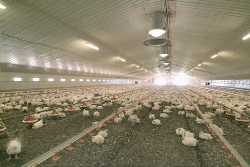
More than three quarters of poultry producers recognise water as a significant factor in the spread of disease, a telephone survey has shown.
While emphasis is placed on thorough cleansing and disinfection of water systems at turnaround, with many producers also routinely adding a sanitising treatment to the drinking lines, microbial loading is still evident when water is tested at the point of drinking.
"Bird health and hygiene have long been priorities for the UK poultry industry, with producers striving to meet market demands for safe, high quality poultry products in the most efficient way," says Tom Ritchie of Forum Bioscience, which commissioned the survey.
"Although water is established as one of several routes by which pathogens are transmitted, the value of effective water sanitisation is easily underestimated," Mr Ritchie believes.
"It is alarming to discover that microbial counts of over 100,000 cfu/ml are commonly found in chemically treated water at the point of drinking - results that are all the more worrying given that poultry vets have shown concern at microbial counts over 300cfu/ml."
Among the microbes likely to found in drinking water are Salmonella, E.coli, Pseudomonas and Campylobacter, all of which can be instrumental in incidences of food-borne disease.
"By setting the target to reduce the number of chickens testing positive for Campylobacter by 50% by 2010, the FSA has underlined another challenge for the industry.
"In light of this, and consumer concerns over residues in meat products, producers must choose an effective way to sanitise their birds' drinking water," Mr Ritchie advises.
Mr Ritchie noted how producers who had adopted the company's Aqualution system, which produces a biocide in the form of 'activated' water, were now seeing zero TVCs, as all bacteria, viruses, fungi and are completely eliminated, right up to the point of drinking.
